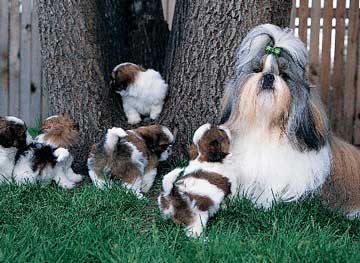Just Like Clockwork
Used with permission from Today’s Breeder magazine, Nestle Purina PetCare
Knowing when to breed a bitch in heat is just like clockwork.
Wait until the middle of her three-week heat, when she is ovulating,
and then three or four days later, conception is most likely to occur.
Not so, say the experts.
 "The most common problem I see breeders deal with in reproduction is the timing in getting a bitch pregnant," says Frances Smith, D.V.M., Ph.D., a board-certified small animal reproduction specialist, in Burnsville, Minn. "Using the old school method of breeding on certain days, like 10 and 13, isn’t going to give you the best results. In fact, even when both the dog and bitch are healthy and you breed at the right time, 15 percent of the time the mating still won’t result in a litter."
"The most common problem I see breeders deal with in reproduction is the timing in getting a bitch pregnant," says Frances Smith, D.V.M., Ph.D., a board-certified small animal reproduction specialist, in Burnsville, Minn. "Using the old school method of breeding on certain days, like 10 and 13, isn’t going to give you the best results. In fact, even when both the dog and bitch are healthy and you breed at the right time, 15 percent of the time the mating still won’t result in a litter."
Robert Hutchison, D.V.M., who specializes in canine reproduction in North Ridgeville, Ohio, agrees. "Poor timing is still one of the main causes of a missed breeding," he says. "Bitches have a three-week heat cycle on average, but there is a lot of individual variation, and breeding on only three or four of those days will result in fertilization. There really is no magic day. I’ve seen a bitch ovulate on day eight and another one ovulate on day 32."
Tracking Hormone Rates
Progesterone testing is one way breeders can know when a female dog is ovulating, and thus determine the ideal time to breed. "Progesterone testing is the single most important tool we have as breeders," says Smith, who breeds Labrador Retrievers.
"You can’t live without progesterone testing," Hutchison says. "No two bitches of any breed are the same. We recently had a bitch that ovulated on day 32. We bred her using frozen semen on day 35, and she’s loaded with puppies. That would not have been possible without progesterone testing."
Progesterone is a reproductive hormone that begins to increase in the bloodstream just prior to ovulation. For most bitches a progesterone reading of 2.0 nanograms (one billionth of a gram) indicates a surge in the luteinizing hormone (LH) from the pituitary gland, which triggers the release of eggs from the follicles, Hutchison explains. When progesterone levels reach 5.0 to 10.0 nanograms, a bitch is ovulating.
After ovulation, the released eggs continue to go through maturation until they are mature two to three days later. Phyllis Giroux, D.V.M., who concentrates on veterinary sports medicine and reproduction in her practice and is a breeder of Labrador Retrievers and Norwich Terriers in Goldvein, Va., says, "Canines have multiple ovulating eggs that may not be released at exactly the same time. Once the maturation process is completed, the eggs are ready for fertilization. As a result, the prime time to breed is 48 to 72 hours post ovulation."
 Progesterone kits that chart progesterone levels through color changes are available to breeders from veterinarians. "It is better to know the quantitative progesterone level (measured in nanograms), which can be determined by a commercial laboratory. Depending on the area of the country, some people can get progesterone results every day while in other areas, it may take up to three days. At our clinic, we have technology that allows us to measure progesterone in one hour."
Progesterone kits that chart progesterone levels through color changes are available to breeders from veterinarians. "It is better to know the quantitative progesterone level (measured in nanograms), which can be determined by a commercial laboratory. Depending on the area of the country, some people can get progesterone results every day while in other areas, it may take up to three days. At our clinic, we have technology that allows us to measure progesterone in one hour."
"In cases where it takes longer, breeders must use a combination of the laboratory test and behavioral changes to help pinpoint the time," Smith says. "To accurately identify the time of ovulation, a series of progesterone tests are conducted to map the rise of progesterone levels. Multiple testing becomes even more critical when chilled semen is being shipped to the bitch owner in another state or country and when using frozen semen. Both require the most precise timing to increase the potential for fertilization."
The key information breeders gain from progesterone testing is finding out when a bitch ovulates. This significantly increases the chance of a successful breeding. "Once you've confirmed ovulation with progesterone testing, you also know that a bitch’s due date is 62 to 64 days later," Smith says.
Hutchison adds, "When you progesterone test for ovulation and use that information to time your breeding appropriately, you're also more likely to get a larger litter size."
Benefits of Artificial Insemination
Even before a breeder tries to determine ovulation, he or she must determine the best method of breeding. In certain situations, several factors can make artificial insemination (AI) preferable over natural breeding, say Smith and Hutchison. "For one thing, it may be more economical to collect and ship semen for AI than to transport a bitch for breeding," Smith says. AI also alleviates the stress caused by shipping a bitch to the stud dog. "There’s no question about it, stress will alter a bitch’s heat cycle," she says.
For a stud dog "semen can be collected without interrupting a successful show or field career," Hutchison says. "It also allows for the semen to be tested prior to the breeding to make sure it is viable."
Other reasons to opt for AI include:
- A significant size difference in the breeding pair.
- Older bitches may have changes in the cervix that interfere with vaginal insemination.
- Time constraints on the part of the breeder or the stud dog owner.
- Risk of injury.
As for choosing a method for collecting and preserving sperm, fresh semen can have as good a conception rate as a natural mating in a dog and bitch with normal fertility, Smith says. "Fresh dog sperm lives 11 days and is capable of fertilizing an egg for six of those days. A breeding with fresh semen will provide a breeder the most flexibility when it comes to timing, and insemination can occur before and after ovulation."
By comparison, fresh chilled semen is viable for 48 hours and frozen semen for only 12 hours. Whenever possible, Hutchison encourages breeders to use fresh chilled semen as opposed to shipping a female to a stud dog. "There’s no reason not to use fresh chilled semen and AI," he says. "Its conception rate can rival fresh semen, and it’s a lot less stressful on the bitch than shipping."
"Frozen semen has a very short fertilizing life, so timing is critical," Smith says. "Using frozen semen also requires careful attention to semen thawing as it can readily be damaged during thawing and preparation for insemination. Surgical insemination results in the highest fertility when using frozen semen."
Planning a C-Section
The second most common problem — after determining the ideal time to breed — is losing puppies during labor, say Smith and Hutchison. "The major reason breeders lose puppies is that they let bitches labor too long without getting help," Smith says.
"Breeders often think that the No. 1 cause of losing puppies is infection, but it’s actually prolonged labor and dystocia (difficulty delivering)," Hutchison says. "Only two things keep a puppy oxygenated in the uterus, their heartbeat and the oxygen they receive through uterine blood flow. Oxytocin, a hormone given to bitches to stimulate contractions, is sometimes given to aid in whelping; however, when oxytocin administration is ill-timed, hypoxia (a deficiency of oxygen) may develop in puppies. Drugs like oxytocin should not be given without veterinary consultation."
Smith believes that a properly timed C-section will result in the best survival time. "If a bitch is having a difficult labor, there is no reason to avoid a C-section," she says. "Improved anesthesia make this surgery very safe for the bitch, and it gives puppies the best chance for survival."
Signs that indicate a difficult labor and the need for medical intervention include:
- A bitch’s temperature drops and no signs of labor begin within 24 hours. Some veterinarians recommend to start taking the temperature of the bitch two or three times daily about one week prior to anticipated whelping. This will help to ensure you do not miss the temperature drop that signals oncoming whelping.
- The bitch strains for longer than an hour in hard labor without delivering a puppy.
- More than three hours elapse between the births of puppies.
- Green, black or red discharge can be seen before delivery, indicating placental separation.
Breeding Considerations
Breeders know firsthand how much effort goes into producing a healthy litter of puppies. From choosing the best type of breeding — whether it’s some form of AI or natural breeding — to knowing the best time to breed, breeders make many decisions. A successful outcome is more likely when a breeder uses the tools, such as progesterone testing, at his fingertips and knows what is best for his or her individual bitch. Then you might say breeding is just like clockwork.
 The Perfect Litter
The Perfect Litter
Breeders define a successful litter in many different ways. Here is a sampling of answers from breeders queried by Today's Breeder.
A successful litter is one "that is very uniform in quality," says Phyllis Giroux, D.V.M, a Labrador Retriever breeder in Goldvein, Va. "I like to see a litter in which all pups of similar body type and size are vigorous and healthy. When a consistent litter is produced, a breeder has done a good job matching the genetic qualities of the parents."
Betty Claire Peacock, a breeder of Pekingese in Dumas, Ark., says, "A successful litter is a healthy litter with good temperament and nice structure."
"Every breeder has to establish his or her own standards for a successful litter," says brace Beagle breeder Ralph Gillum of Northville, Mich. ""For me a successful litter is one that produces at least one pup to keep as a breeding member of my kennel. It takes a real good pup to be a keeper. A keeper must maintain or enhance the performance level of the kennel."
Having Puppies: A Personal Account
Phyllis Giroux, D.V.M., who breeds Labrador Retrievers under the Deep Run Retrievers kennel name in Goldvein, Va., recalls breeding one of her nicest yellow females to a famous field trial dog several years ago. "We had a lot of interest in the litter, and many people wanted to place deposits for these promising pups. Although I knew she was pregnant, I decided to have an ultrasound to see if we could get some idea of the number of pups she would have."
The ultrasound — an imaging procedure in which high-frequency sound waves are used to show fetal images — showed eight healthy pups. A few weeks later, Giroux says, the female went into labor around 10 p.m. on her due date. "I sat up with her through the night and assisted while she delivered six pups. The interval between pups slowed a bit, then around 6 a.m., she had a nice big male."
"At 8 a.m., she had a smaller female," Giroux says. "She was pretty restless, and I wanted to clean up the whelping area. Assuming this was the last pup, I let her outside to stretch her legs and eliminate. In a matter of three or four minutes, I let her back in, gave her some fresh water and a little snack, and she settled down to nurse and care for her pups."
"About 15 minutes later, one of my older male dogs started scratching on the front door. This was unusual behavior for him, as he is generally quite a gentleman and waits patiently for someone to let him in. I went to the door to let him in. Imagine my astonishment to discover that he held in his mouth a squalling, newborn pup! The mom must have had him when outside on her own."
Apparently, the ultrasound did not show all of the puppies, Giroux says. "We now realize that ultrasound is not reliable for counting pups. Since that time, I never let a mom out unattended, unless I have a radiograph (an X-ray image) confirming that there are no more pups to be born."
 Getting Ready to Breed
Getting Ready to Breed
A lot of work goes into getting ready to breed. First, you study pedigrees and select the best breeding pair. Next, you make sure the bitch and stud dog are healthy and ready to breed. Here are some considerations before breeding.
Stud Dog Viability
A healthy male dog is crucial for successful breeding. One way to determine his viability is to have a veterinarian perform a male breeding soundness evaluation (BSE). The one hour examination ensures the dog's fertility, says Frances Smith, D.V.M., Ph.D., a board-certified reproduction specialist in Burnsville, Minn.
The evaluation includes a complete medical history with vaccination and veterinary records, and dates and times of illnesses and injuries. It also includes results of current and past brucellosis testing, sperm and semen evaluations, the number of females bred successfully, the frequency of ejaculation, and a thorough physical examination.
Smith, who breeds Labrador Retrievers, says, "It's a fallacy that every dog with two testicles produces normal sperm. If you're the owner of a stud dog, it's important to have your dog's semen analyzed. It's also a good idea to do a fresh chilled 'test run' and find out how long your dog's sperm lives using semen extender."
"I would not want to waste a heat on sperm that does not have a chance of success," she says. "If I were going to breed to a dog using frozen sperm, the first question I would ask the stud dog's owner would be if there has ever been a puppy conceived using frozen semen from this dog."
"Some sperm is not worth freezing," she continues. "In general, the younger the dog is at the time that the semen is frozen, the better the chance the sperm will be viable even if used years later. If the sperm is collected later in the dog's life, even if it looks good, the fertility will be different."
Healthy Bitches
Being sure your brood bitch is healthy is paramount to producing healthy litters. "To do the most thorough job of testing prior to breeding, a complete chemistry panel should be performed on the bitch," Smith says. "By checking for normal liver and kidney function as well as normal protein levels, you will have a better idea as to whether she is physically and nutritionally ready to whelp a litter of puppies. Checking for heartworm and parasites goes without saying."
Brucellosis testing is also important, Smith says. "Contrary to popular opinion, brucellosis (a condition causing abortion in the last two weeks of gestation or failure to conceive) can be spread both orally and venereally. It can be in the sperm, and if it is, it does not matter if the breeding is done by AI, the bacteria can survive."
Used with permission from Today’s Breeder magazine, Nestle Purina PetCare




